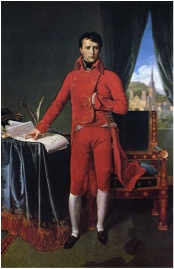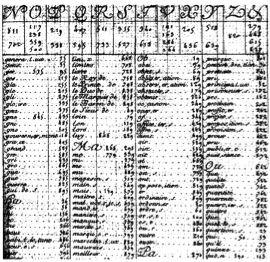By Sarah Giordano (Guest Contributor)

Portrait de Napoléon Bonaparte en premier consul by Jean Auguste Dominique Ingres, Wikimedia Commons, Public Domain
For all his military genius, the one idea that Napoleon could not quite seem to grasp was the importance of cryptography. Most prominently, this failing was seen on the battleground of the Peninsular Wars in Iberia, where the French Empire and the British battled for dominance. Here, flurries of messages were passed amongst army units, often containing information about key military maneuvers or enemy tactics. British cryptanalysts frequently preyed upon French messages, capturing them to see what they could learn. To ensure the security of these messages, the use of strong codes and ciphers was critical. Unfortunately for the French Empire, Napoleon had to learn this lesson the hard way.
The glaring lapse in cryptography on the part of the French army was evident during the capture of one of their officers, General Franceschi, in the Iberian Peninsula. When captured, Franceschi was carrying a letter to Napoleon’s brother, the current King of Spain (Wellesley, 1837). One would think that a letter passing between allied rulers containing military information would be well protected by the strongest ciphers that the French army offered. However, it was not protected at all; with Franchesci’s capture, enemies of the French had instant access to the contents of Napoleon’s letter (Wellesley, 1837). The first lesson that the French needed learn about cryptography: use it.
From the Army of Portugal Code to the Great Paris Cipher
At this point Napoleon began to rethink his methods of security and tasked the French army with creating a large code. The one they created, called the Army of Portugal Code, was not simple; it used approximately 150 numbers, each of which represented either a letter or a word (Bertrand, Heyningen, n.d.). Unfortunately for the French, the British deciphered it in record time. In 1811, a man by the name of Major George Scovell sat down armed only with a beginner’s guide to cryptography and a few captured French messages (Urban, 2001B). Within two days, he had uncovered the current encryption system of the French, giving the advantage to the British and their allies once again.
Evidently, the Bonaparte brothers needed a huge cipher, riddled with dead ends, traps, and tricks in order to effectively confuse their enemies. Thus, at the end of 1811, the Great Paris Cipher, “Le Grande Chiffre de Paris”, was born from the minds of unknown French cryptographers.
The Great Paris Cipher was leaps ahead of the Army Code of Portugal. For instance, the cipher had few underlying patterns, only consisting of a table with words and letters followed by the number with which they were encoded (Urban, 2001 B). The table consisted of approximately 1400 numbers, which served to further increase the security (Urban, 2001 A). A cipher this large should have remained impenetrable for quite some time, because it was nearly impossible to figure out using the common decryption techniques of frequency analysis.
Essentially, frequency analysis, the fundamental decryption method of the time, consists of determining the number of times cipher text symbols appear so that one can determine which symbol corresponds to what “real”, also known as plaintext, letter. For example, if the number ‘4’ appears the most times in an encrypted letter, one might determine that the number 4 stands for the plaintext letter ‘e’, as e is the most common letter both in English and French (Urban, 2001 B). However, in the Great Paris Cipher a single letter would take on multiple numbers according to how frequently the letter was found in the language, a method which is known as homophonic substitution (Urban, 2001 A). Instantly, this renders frequency analysis useless because the frequency of one number in the cipher does not accurately represent the entire frequency of a letter in the plaintext.
To make it even more complicated, some numbers stood for nothing; they were simply included in the cipher text to make enemies even more confused. These “nulls”, as they were termed, were specifically inserted at the ends of words to thwart a common decryption technique of studying similar endings to cipher text words in search of linguistic patterns (Bertrand, Heyningen, n.d.).
Moreover, the Great Paris Cipher added another layer of complexity and variety by technically acting as both a code and a cipher (Bayart, V. &F., n.d.). This meant that a specific number could either be the encryption of a word or phrase (which would make it a code) or it could be the encryption of a syllable or a single letter (which would be described as a cipher). Enemy cryptanalysts would have difficulty discovering which number(s) corresponded to which words because words could be encrypted in many ways: with a number for each letter, for each syllable, for the entire word, or some combination thereof.
Indeed, “Le Grand Chiffre de Paris” was formidable in size and complexity, and had no noticeable underlying patterns. In truth, it seemed like all the security Napoleon needed.
Breaking the Great Paris Cipher
Yet, merely a year after the birth of this cipher, it was broken by Major Scovell, the same man who had broken the Army Code of Portugal. In truth, the Great Paris Cipher found its flaw not in its structure but in its use. In essence, the French were simply too lazy and overconfident in the cipher’s security to use it properly. Instead of encrypting messages using the cipher, the French army would only encrypt part of a message in an effort to cut down on the time spent using the cipher (Bayart, V. & F., n.d.). They mistakenly thought that their cipher would be strong enough to keep the full meaning of their messages a secret. By leaving some words of their message in common French, they provided a cryptanalyst like Scovell with an invaluable foothold, or “crib”, into their cipher.
Essentially, Scovell could use the words in plain text to take an educated guess at what the message might be, leading him to deduce what some encrypted words meant (Urban, 2001 A). Moreover, if the French left a verb out in the open, Scovell could easily decrypt the words around it by analyzing its conjugation (Urban, 2001 B). Slowly as Scovell gathered more cipher text, the number of cribs he collected increased until finally the cipher was completely broken. With this broken cipher, the British gained a serious edge in the Peninsular Wars. Keeping their discovery a secret, they could now collect and decrypt messages containing critical information for the French, resulting in serious repercussions for Napoleon. Using the information gained from “Le Grand Chiffre”, the British beat the French in the final battle for control of Spain (Bertrand, Heyningen, n.d.)
Although heralded as a strategic genius, Napoleon never recognized the importance of cryptography. Even when the French finally developed a competent encryption technique, they made the mistake of trusting in it so much that it was not properly utilized. Had the French sent fewer messages and encrypted the entirety of their letters, “Le Grand Chiffre” could have been nearly unbreakable. The British may not have defeated the French, and Spain might not have been thrust into the hands of revolutionaries instead of remaining under the rule of the current king. Instead, Napoleon practically threw away his information and his advantages. It wasn’t all for naught, however; from the mistakes of the French Empire, the world learned exactly what not to do while passing secret messages.
This post is part of a series of essays on the history of cryptography produced by students at Vanderbilt University in honor of the release of The Imitation Game, a major motion picture about the life of British codebreaker and mathematician Alan Turing. The students wrote these essays for an assignment in a first-year writing seminar taught by mathematics instructor Derek Bruff. For more information on the cryptography seminar, see the course blog. And for more information on The Imitation Game, which opens in the US on November 28, 2014, see the film’s website.
Sources:
Bayart, V. & F. Le Grand Chiffre de Paris (n.d.). Retrieved October 15, 2014, from http://www.bibmath.net/crypto/index.php?action=affiche&quoi=ancienne/napoleon
Bertrand, C., & Heyningen, E. Secrets and Spies: The Great Paris Cipher. (n.d.). Retrieved October 15, 2014, from http://www.nationalarchives.gov.uk/spies/ciphers/scovell/default.htm
Urban, Mark. (2001 A.) The Man Who Broke Napoleon’s Codes: The Story of George Scovell. London: Faber and Faber.
Urban, M. (2001B, October 24). Wellington’s Lucky Break. Retrieved October 15, 2014.
Wellesley, A., & Gurwood, J. (1837). Dispatches of the Field Marshall the Duke of Wellington, K.G.: During His Various Campaigns in India, Denmark, Portugal, Spain, the Low Countries, and France (pp. 498-499). John Murray, Albemarle Street.

